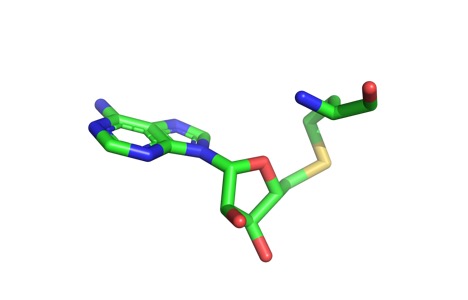User:Lauryn Padgett/Sandbox 1
From Proteopedia
(Difference between revisions)
| Line 1: | Line 1: | ||
| - | <scene name='81/811086/Beta_hairpin/2'>Text To Be Displayed</scene>''Homo sapiens'' Histone Methyl Transferase SET7/9 (KMT)== | + | <scene name='81/811086/Type_ii_beta_turns/2'>Text To Be Displayed</scene><scene name='81/811086/Beta_hairpin/2'>Text To Be Displayed</scene>''Homo sapiens'' Histone Methyl Transferase SET7/9 (KMT)== |
<StructureSection load='1o9s' size='350' frame='true' side='right' caption='KMT 1o9s' > | <StructureSection load='1o9s' size='350' frame='true' side='right' caption='KMT 1o9s' > | ||
| Line 9: | Line 9: | ||
===Overall Secondary Structure=== | ===Overall Secondary Structure=== | ||
| - | The secondary structure is composed of 10% <scene name='81/811086/Helices/3'>helices</scene> and 37% <scene name='81/811086/Beta_sheets/3'>beta sheets</scene>. The helical composition includes 3 <scene name='81/811086/Alpha_helices/4'>alpha helices</scene>, with two residing in the SET domain and one in the C-terminal domain. The alpha helices in the SET domain are two turns while the C-terminal helix is by far the largest with 4 turns. There are also 2 <scene name='81/811086/3-10_helices/4'>3-10 helices</scene> in the SET domain which are each one turn. There are 21 total beta strands which reside in the N-terminal domain and the SET domain. The beta strands are primarily anti-parallel and multiple antiparallel strands are connected by <scene name='81/811086/Type_i_beta_turns/3'>Type I</scene> and | + | The secondary structure is composed of 10% <scene name='81/811086/Helices/3'>helices</scene> and 37% <scene name='81/811086/Beta_sheets/3'>beta sheets</scene>. The helical composition includes 3 <scene name='81/811086/Alpha_helices/4'>alpha helices</scene>, with two residing in the SET domain and one in the C-terminal domain. The alpha helices in the SET domain are two turns while the C-terminal helix is by far the largest with 4 turns. There are also 2 <scene name='81/811086/3-10_helices/4'>3-10 helices</scene> in the SET domain which are each one turn. There are 21 total beta strands which reside in the N-terminal domain and the SET domain. The beta strands are primarily anti-parallel and multiple antiparallel strands are connected by <scene name='81/811086/Type_i_beta_turns/3'>Type I</scene> and <scene name='81/811086/Type_ii_beta_turns/2'>Type II</scene> beta turns. |
The <scene name='81/811091/C_terminal_domain/1'>C-terminal Domain</scene> of the protein is essential for the binding and stabilization of the cofactor. The | The <scene name='81/811091/C_terminal_domain/1'>C-terminal Domain</scene> of the protein is essential for the binding and stabilization of the cofactor. The | ||
| Line 16: | Line 16: | ||
<scene name='81/811086/Helices/3'>helices</scene> | <scene name='81/811086/Helices/3'>helices</scene> | ||
<scene name='81/811086/Beta_sheets/3'>beta sheets</scene> | <scene name='81/811086/Beta_sheets/3'>beta sheets</scene> | ||
| - | <scene name='81/811086/Type_i_beta_turns/3'>Type I</scene> | + | <scene name='81/811086/Type_i_beta_turns/3'>Type I</scene> |
| + | <scene name='81/811086/Type_ii_beta_turns/2'>Type II</scene> | ||
<scene name='81/811086/Beta_hairpin/2'>beta hairpin</scene> | <scene name='81/811086/Beta_hairpin/2'>beta hairpin</scene> | ||
Revision as of 21:23, 9 April 2019
Homo sapiens Histone Methyl Transferase SET7/9 (KMT)==
| |||||||||||
References
- ↑ Hanson, R. M., Prilusky, J., Renjian, Z., Nakane, T. and Sussman, J. L. (2013), JSmol and the Next-Generation Web-Based Representation of 3D Molecular Structure as Applied to Proteopedia. Isr. J. Chem., 53:207-216. doi:http://dx.doi.org/10.1002/ijch.201300024
- ↑ Herraez A. Biomolecules in the computer: Jmol to the rescue. Biochem Mol Biol Educ. 2006 Jul;34(4):255-61. doi: 10.1002/bmb.2006.494034042644. PMID:21638687 doi:10.1002/bmb.2006.494034042644
Schluckebier et al. (1997), Differential binding of S-andeosylmethionine S-adenosylhomocysteine and Sinefungin to adenine-specific DNA methyltransferase M. TaqI; J. Mol. Biol., 265 56

